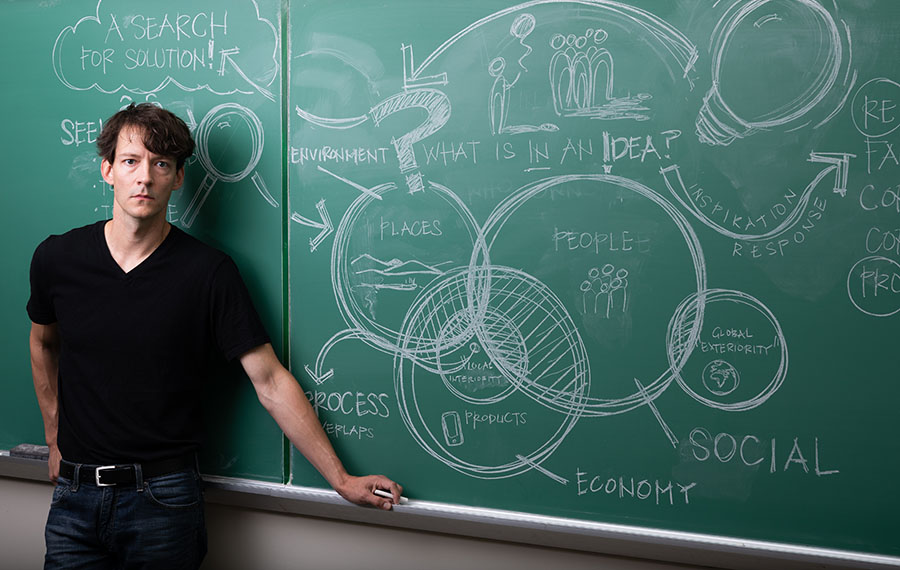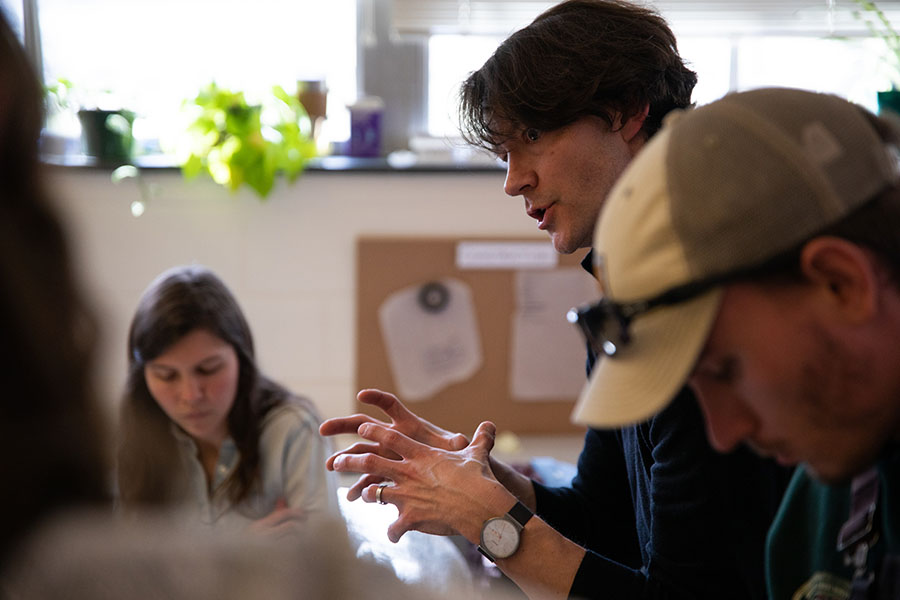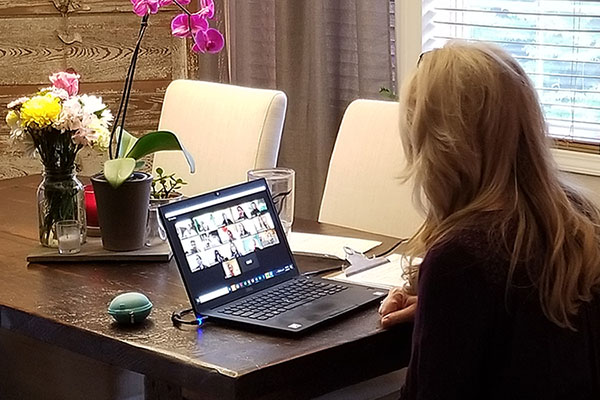
D. Jason Miller, associate dean of Appalachian’s College of Fine and Applied Arts and associate professor in the college’s Department of Sustainable Technology and the Built Environment (STBE), in his classroom. Miller was the recipient of the 2019 UNC Board of Governors Excellence in Teaching Award. Photo submitted
“This atmosphere of shared learning and shared ideas relies on proximity and access to a shared space. In the shift to an online studio environment, my energy and focus were on fostering that type of atmosphere by ‘holding space’ in synchronous studio meetings for students to work on their projects in a shared setting.”
D. Jason Miller
D. Jason Miller is the newly appointed associate dean of Appalachian’s College of Fine and Applied Arts and associate professor in the Department of Sustainable Technology and the Built Environment (STBE). He is a licensed architect with his own design firm, David Jason Miller Architect PLLC, and he integrates lessons from his professional work into the classroom.
In Miller’s classes, students work in a studio atmosphere with real clients on real projects — designing, planning and constructing for mostly local government agencies and nonprofit organizations.
Miller was the recipient of the 2019 UNC Board of Governors Excellence in Teaching Award. In this Q&A, he shares how he maintained the learning atmosphere Appalachian is known for providing, despite a shift to online instruction in spring 2020 because of the coronavirus pandemic.
- What were some of your challenges and creative solutions in making online classes most effective?
-
As a design educator and professional, the challenge of working online isn’t the technology interface or workflow of design process and production. Those tools offer relatively simple pivots into online formats. Screen sharing, remote access and control, annotations, video recordings and other resources offer opportunities to maintain individual creativity while working on a design project.
The real challenge, I have found, is in redeveloping the atmosphere and culture of a design studio environment in a virtual space. Students collaborate, coordinate and create in response to one another. This atmosphere of shared learning and shared ideas relies on proximity and access to a shared space.
In the shift to an online studio environment, my energy and focus were on fostering that type of atmosphere by “holding space” in synchronous studio meetings for students to work on their projects in a shared setting. Breakout rooms allowed small groups to peer review or receive one-on-one desk critiques on the work in progress.
At the beginning of each studio session, we discussed the lessons being learned in real time that will impact the design professions and the built environment. Demonstrations or presentations on resources, software and precedents for the current assignment were provided and recorded.
A different student co-hosted each Zoom studio session with me and provided insights and strategies for us to try during the next studio meeting to improve efficiency and efficacy. Asking for and expecting student engagement in the course itself — rather than just the work assigned — presents a renewed sense of student agency and the spirit of a studio atmosphere.

D. Jason Miller, associate dean of Appalachian’s College of Fine and Applied Arts and associate professor in the college’s Department of Sustainable Technology and the Built Environment (STBE), is pictured teaching in Appalachian’s IDEXlab. Photo submitted
- How did you handle the parts of your teaching that required a hands-on approach?
-
Applied learning through hands-on work is the essential core of a studio-based course. Online, hands-on learning requires a slightly different approach. Tutorial links and real-time video demonstrations of useful software platforms, sketching or modeling techniques provide reasonable, if imperfect, alternatives.
By using annotation functionality in web-based conferencing applications, it was possible to comment on work being shared by students through sketching and diagramming — though my virtual sketching skills are still a work in progress. By requesting remote access control of a student’s screen, I was able to navigate a design file in progress to clarify my design critiques and offer suggestions.
- Do you have any tips, success stories to share?
-
By and large, the work in my studio and construction safety courses during the spring semester was reliant on consistent and effective communication. Communication — through multiple channels — is even more important now. Erring on the side of “tl;dr” (an internet abbreviation for too long; didn’t read) is OK! Providing resources, sharing new information, sending a video clip or offering a reflective thought that demonstrates care and understanding — our students feel most supported when they feel you are present and invested.
What do you think?
Share your feedback on this story.
About the College of Fine and Applied Arts
Appalachian State University’s College of Fine and Applied Arts is a dynamic and innovative group of seven academic departments, bringing together a variety of perspectives, experiences and real-world education to provide unique opportunities for student success. The college has more than 3,500 undergraduate and graduate majors. Its departments are Applied Design, Art, Communication, Military Science and Leadership, Sustainable Development, Sustainable Technology and the Built Environment, and Theatre and Dance. Learn more at https://cfaa.appstate.edu.
About Appalachian State University
As a premier public institution, Appalachian State University prepares students to lead purposeful lives. App State is one of 17 campuses in the University of North Carolina System, with a national reputation for innovative teaching and opening access to a high-quality, cost-effective education. The university enrolls more than 21,000 students, has a low student-to-faculty ratio and offers more than 150 undergraduate and 80 graduate majors at its Boone and Hickory campuses and through App State Online. Learn more at https://www.appstate.edu.












